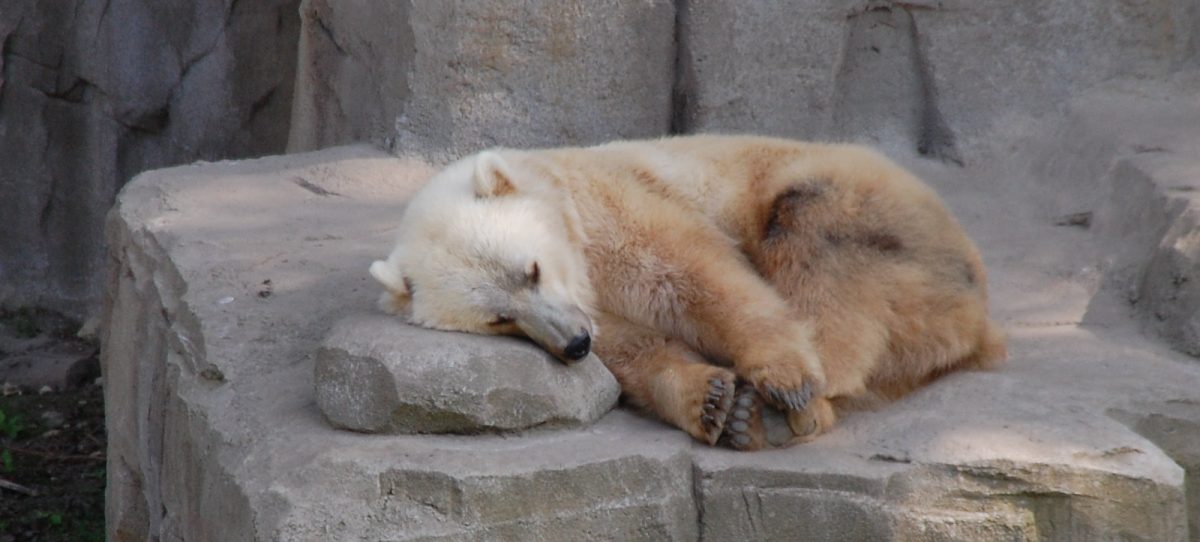
Hybridization between Polar and Grizzly bears may not be as common as we think, according to new research by Ruth Rivkin and other. Photo credit: Stefan David, Flikr
UM researcher helps to track Grolar or Pizzly bears
UM researcher, Ruth Rivkin, is part of a team that developed a chip to track hybridization between polar and grizzly bears.
A UM researcher is part of team of North American researchers who used a new chip to track the diversity and hybridization between polar bears and grizzly bears. Ruth Rivkin, postdoctoral research fellow with Polar Bears International, University of Manitoba, and the San Diego Zoo Wildlife Alliance and the team just published their findings of the first-ever large-scale analysis of how often hybrids of polar and grizzly bears exist in the wild in the journal, Conservation Genetics Resources.
Rivkin and researchers from Environment and Climate Change Canada, Polar Bears International, MacEwan University, Government of Northwest Territories, and San Diego Zoo Wildlife Alliance developed an innovative SNP genetic sequencing chip, a new tool, to analyze samples from polar and grizzly bears. Their report analyzed 371 historic polar bear and 440 historic grizzly bear samples from across Canada, Alaska, and Greenland and confirmed that only the eight already-known are hybrids, thus underscoring the rarity of hybridization.
Range expansion, facilitates hybridization of two large carnivores
“Polar bears evolved from grizzly bears several hundred thousand years ago and although gene flow has occurred between the two species in the past, it appears that recent hybridization is restricted to a small group of polar bears and brown bears in the western Arctic,” says co-author Evan Richardson, Research Scientist at Environment and Climate Change Canada, adding, “This study develops a new genomic toolset to rapidly detect hybrids and indicates that contemporary hybridization is not a conservation concern.”
Hybridization, increasing but rare
This report answers the question of, “How many polar-grizzly bear hybrids are there?” which responds to an expectation that the numbers of polar-grizzly hybrids were increasing. Out of 819 wild grizzly and polar bears across Canada, Alaska, and Greenland, encompassing four subpopulations, this report found that only eight hybrids exist, or 1 per cent of the samples, collected between 1975 and 2015. The first hybrid did not appear until 2006. While it is a rare occurrence, it is a recent one, suggesting hybridization is a result of warming temperatures causing their habitats to increasingly overlap.
“We were surprised to find no new cases of polar-grizzly hybrids despite speculation of increasing numbers,” says Rivkin, who also co-authored the study. “We’re proud that this new chip allows rapid identification of polar-grizzly bear hybrids, which will be an important tool as the climate warms and polar and grizzly bears come increasingly into contact.”
About hybrids (also known as pizzly bears or grolar bears)
Hybrids of grizzly and polar bears are often referred to as grolar or pizzly bears depending on the paternal lineage, i.e., a grolar bear when the father is a grizzly bear, and a pizzly bear when the father is a polar bear. This study confirms the existence of eight known grolar bears in the wild as the descendants of one female polar bear. Hybridization is only possible in areas where grizzly and polar bear distributions overlap (thus excluding regions like the high Arctic). Hybridization is uncommon but expected to increase as climate change pushes grizzly bears northward, increasingly into polar bear territories, but hybrids are still ill-suited to adapt to the changing Arctic.
“This report underscores that hybridization is remarkably rare, and that hybridization is not an adaptive capability of polar bears,” says Geoff York, senior director of research and policy at Polar Bears International, who was not involved in the report. “The report introduces a new tool for wildlife managers to use as they evolve their strategies due to a warming climate and changing ecosystems.”
Technological breakthrough
This research developed the new 8K genotyping chip, called the Ursus maritimus V2 SNP chip, which is a genetic tool used to analyze polar bear samples in a lab. It reads the genetic samples, allowing rapid and reliable genome analysis and spots polar bear-grizzly hybrids with 100 per cent accuracy. The Ursus maritimus V2 SNP chip is a result of years of development through the Genomics Research and Development Initiative STAGE funding by Environment and Climate Change Canada. The authors had access to long-term, robust polar bear data from Canadian government and territorial monitoring programs, which have been collecting data since 1966, and which were critical to the research and Ursus maritimus V2 SNP chip development. This chip is an important tool for wildlife managers, scientists, policymakers, and conservationists to identify hybrid bears and further enable their protection and more effective wildlife management.
“Our newly developed technology allows rapid and accurate consideration of over 8,000 genetic markers in polar bears,” notes lead author Dr. Joshua Miller, Assistant Professor, Biological Sciences, MacEwan University, adding “This will allow for the assessment and monitoring of genetic diversity, which is a key part of a species’ ability to survive changing environmental conditions.”
Research at the University of Manitoba is partially supported by funding from the Government of Canada Research Support Fund.






